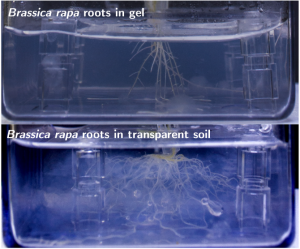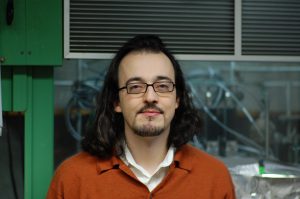Ludovico Cademartiri and his research group have been working to provide tools for plant science and agronomy since 2012. After five years, their research has made major advancements for the plant science and agriculture communities enabling them to develop transparent soil technology and receive a generous grant from the National Institute of Food and Agriculture.
In early February, the U.S. Department of Agriculture’s (USDA) National Institute of Food and Agriculture (NIFA) announced 11 grants totaling $3 million to advance plant and animal phenomics and microbiomes. Ludovico Cademartiri, Assistant Professor in the Department of Materials Science and Engineering and Associate Scientist at U.S. Department of Energy’s Ames Laboratory, received a grant for $270,000, together with Rebecca Cademartiri, an Adjunct Assistant Professor in the Departments of Chemical & Biological Engineering and Materials Science & Engineering, and Asheesh Singh, an Assistant Professor in the Department of Agronomy. His proposal was one of three from Iowa State University to receive funding through this NIFA grant, further cementing the status of Iowa State as a national leader in phenomics. These grants will advance new technologies and methods to solve societal challenges and ensure agriculture viability for the future.
Transparent Soil Technologies for Root and Rhizosphere Phenotyping
Cademartiri leads a multidisciplinary team of engineers, plant scientists, and microbiologists who focus on a variety of research programs spanning nanotechnology and manufacturing. One of these programs includes applying materials engineering thinking to problems in biology such as the phenotyping of roots and rhizospheres.
It is crucial to understand the way in which a plant survives in a variety of stressful conditions such as drought, flooding, or soil erosion. It is important to study the root system and the way a plant holds itself in the ground, interacts with microbes and other organisms, and intakes nutrients to survive.

Since the soil is opaque, the study of the interactions of plant roots with their rhizosphere – the region of the soil around plant roots that is directly influenced by root secretions – is especially complicated. The current method for phenotyping and characterizing plants is a quick technique called “shovelomics.” As expected from the name, the plant is dug out of the soil, and the root system is exposed by washing away the soil. The procedure can only be performed at the end of a plant’s growing season. Another method used when phenotyping plants is hydroponics. Hydroponics allows plant growth to occur in a water solution that is transparent, therefore allowing easy monitoring of the root system. The challenge with hydroponics is that plant roots need oxygen, and hydroponic conditions lack oxygen. As a result, the development of roots in hydroponics does not usually match what is observed in the soil.
Due to the challenges with current methods, the questions became simple: how do we look at a root system while a plant is still growing? How do we create an environment that provides nutrients, water, and oxygen to the root system? Lastly, how do we make this porous material transparent?
The idea was to create a transparent soil that is easy to produce and has high production rates at a relatively low cost. The soil is highly controllable and will produce phenotypes representative of those observed in real soil.
How did Cademartiri’s group make transparent soil? By using a material that is optically similar to water, a temporary saturation with nutrient solution makes it transparent. The material can be controlled, produced in mass quantities, and modified in different ways to provide different properties and functionalities.

Cademartiri’s research and observing plant root phenotypes is important for the seed industry and plant breeding community to determine how to improve plant viability under stressful conditions. With the NIFA grant and advancements in creating an ideal transparent soil, finding a way to commercialize their final product will be a high priority.
According to Professor Cademartiri, “The goal of the grant is to assess whether the development of roots in our “soil” is representative of what happens in real soil. We are working on a multidisciplinary project that identifies a need in the plant science community that can be met by applying engineering principles and methods to problems outside of traditional engineering, and that is why people like it.”